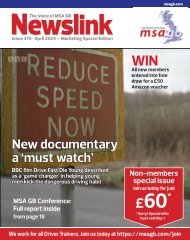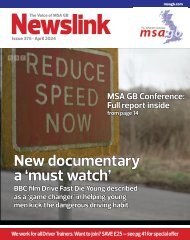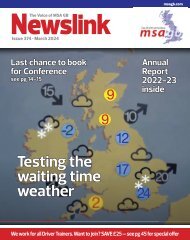Newslink October 2021
Membership magazine of the Motor Schools Association; road safety, driver training and testing news.
Membership magazine of the Motor Schools Association; road safety, driver training and testing news.
Create successful ePaper yourself
Turn your PDF publications into a flip-book with our unique Google optimized e-Paper software.
Feature: Changes to the L-test<br />
The L-test has always been<br />
subject to change<br />
Mike Yeomans<br />
MSA GB North East<br />
A driving test crica 1935. It’s difficult to ascertain whether the<br />
lady in view is an interested by-stander, an examiner or perhaps<br />
the candidate waiting for the driver to let her behind the wheel.<br />
One hopes, however, that the driver’s observation skills meant<br />
he spotted her before he moved much further forward!<br />
In 1997 a new test category was created<br />
for a car with large trailer, (B+E)<br />
For many years now we ADIs have<br />
been critical of the fact you can teach<br />
trailer and car (B+E) without being an<br />
ADI, getting paid and running a business.<br />
Of course, this is still true, but the<br />
desire to take a test to be able to pull a<br />
trailer has only ever been a necessity<br />
because there was a test to take.<br />
As you will have read elsewhere in this<br />
issue, the DVSA’s plan is that there will<br />
no longer be a B+E test to take.<br />
So you could argue that ADIs have<br />
won a small battle and that non-ADIs<br />
have lost a business, but then, so have<br />
those many ADIs who took the time and<br />
money to get qualified, were professional<br />
and created a B+E training business to<br />
meet the test demands.<br />
The only positive for them is that, as<br />
an ADI, they are still qualified to teach<br />
and currently there is plenty of work<br />
around to satisfy our needs, so hopefully<br />
they can pick up ‘standard’ learner pupils<br />
to teach.<br />
Despite this positive, however, I<br />
thought it was very cruel when I read on<br />
social media people saying “all these<br />
B+E trainers and business have only lost<br />
the cost of a trailer, they can still teach,<br />
what’s their beef?”<br />
The biggest issue for any business or<br />
redundancy is to be notified only a week<br />
or so before the collapse of a business,<br />
and this was the case with the DVSA for<br />
so many of the trailer trainers.<br />
I hope by the time this article is read<br />
some compensation has been fought for<br />
and won, to assist those whose work has<br />
been lost so quickly.<br />
While I was checking up on when the<br />
B+E test first arrived I became interested<br />
in the history of the test and the myriad<br />
changes that we’ve seen to it over the<br />
years. An article some time ago on the<br />
history of the Highway Code, published<br />
on the www.gov.uk website intrigued me<br />
and highlighted just how many changes<br />
there have been. Were there any<br />
similarities or lessons to be learned from<br />
history to guide us through these current<br />
tumultuous times?<br />
I have removed some of the changes<br />
that were road safety but not part of the<br />
driving test changes.<br />
The reason for publishing this history,<br />
which I’m sure has been produced in<br />
<strong>Newslink</strong> before, is I was struck by the<br />
similarity with current events. Where you<br />
read ‘suspended for the duration of World<br />
War 2’ you can now read ‘suspended due<br />
to Covid-19’... you will also read that<br />
‘examiners were redeployed to traffic<br />
duties and supervision of fuel rationing’<br />
– perhaps this can be compared with the<br />
modern day equivalent, ‘furloughed /<br />
redeployed or shielding’.<br />
What the history does tell you is that<br />
some stories never change: there were<br />
always people waiting for L-tests, the<br />
pass rates were never great and new<br />
tests were introduced or removed in an<br />
almost ad hoc nature.<br />
1930: Regulations introduced covering<br />
endorsements and fitness declaration.<br />
The Road Traffic Act 1930 introduces<br />
licensing system for public service<br />
vehicles (PSV). In the early days of<br />
motoring, one licence covered both cars<br />
and motorcycles use. Age restrictions<br />
and a form of driving tests brought in for<br />
disabled drivers. Full licences for<br />
disabled drivers valid for 1 year.<br />
1931: PSV drivers could be required to<br />
take a test, at discretion of Traffic<br />
Commissioners. The first edition of the<br />
Highway Code was published including<br />
advice for motorcycle riders.<br />
1934: Licences for lorry drivers were<br />
introduced on 16 February 1934 under<br />
the Road Traffic Act, 1934 - the licensing<br />
authority could require the applicant to<br />
submit to a practical test of their ability.<br />
1935: Voluntary testing was introduced<br />
on 16 March 1935 by the Road Traffic<br />
Act 1934. This was done to avoid a rush<br />
of candidates when the test becomes<br />
compulsory.<br />
Mr R Beere was the first person to<br />
pass the driving test, at a cost of 7s 6d<br />
26<br />
NEWSLINK n OCTOBER <strong>2021</strong>

















